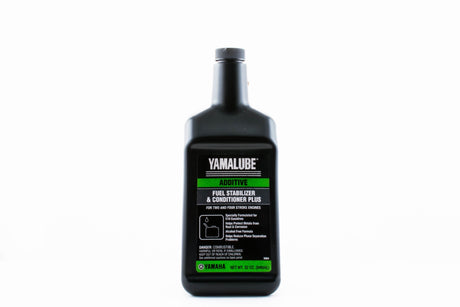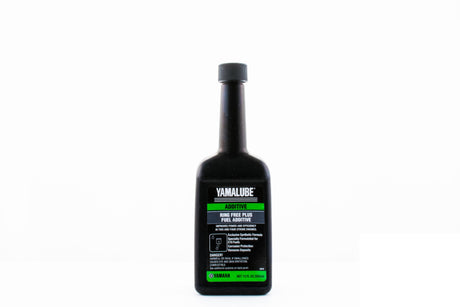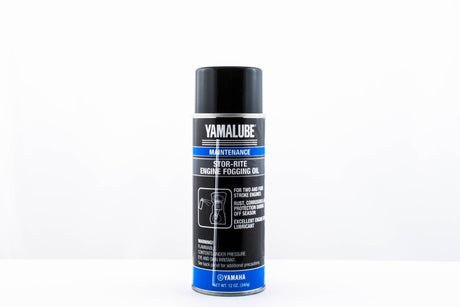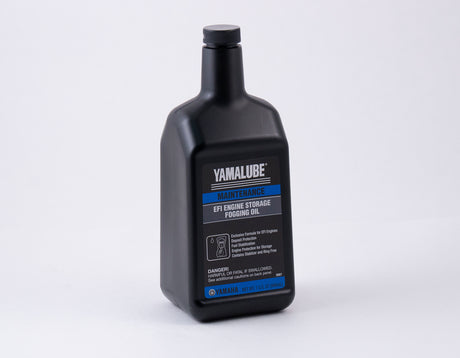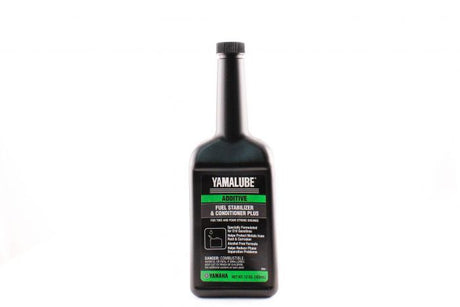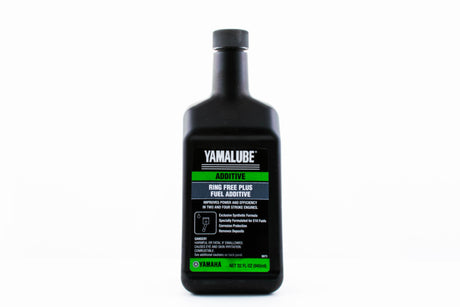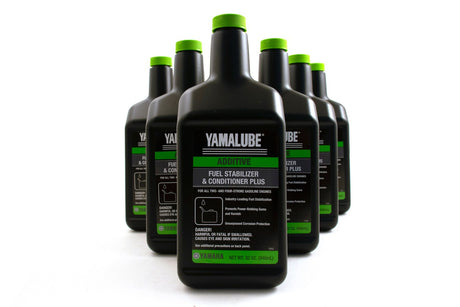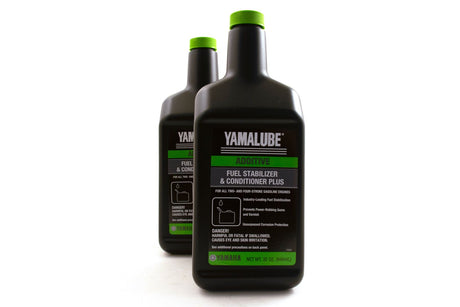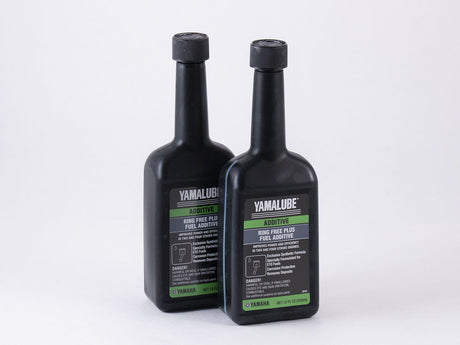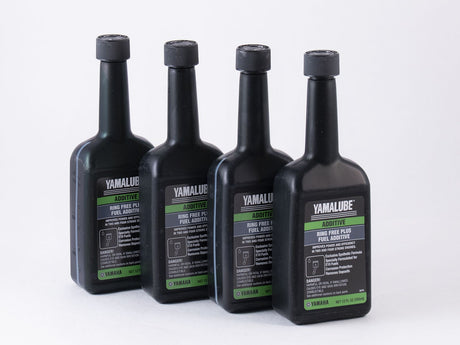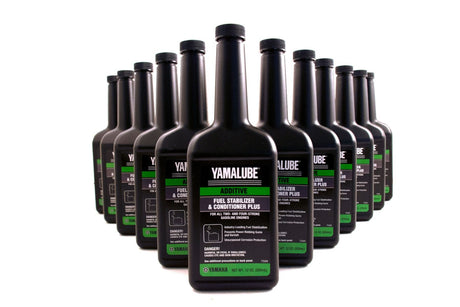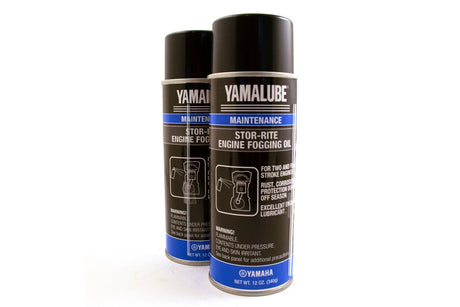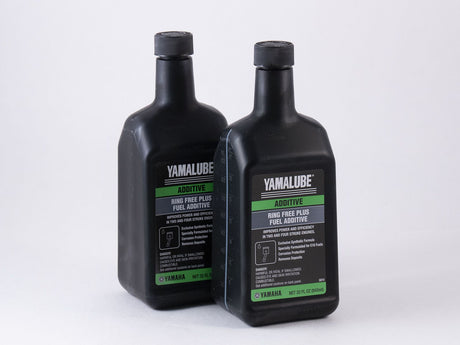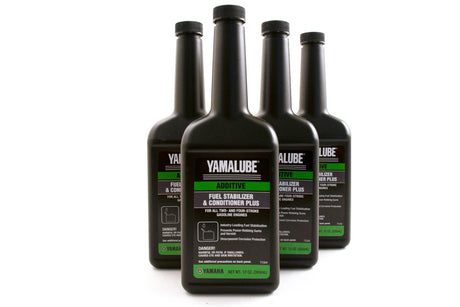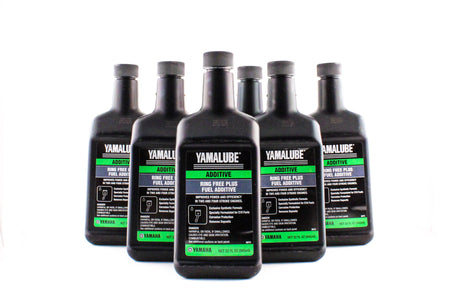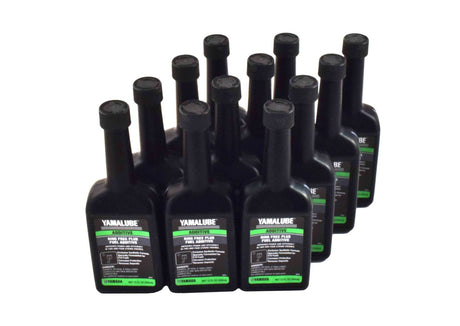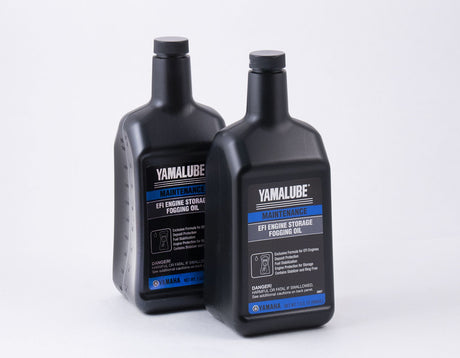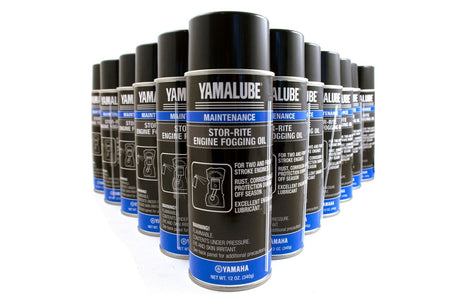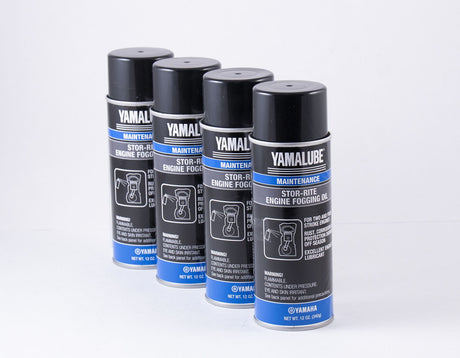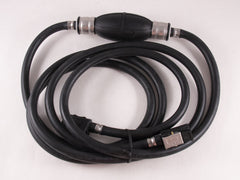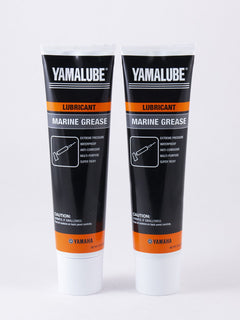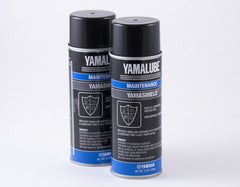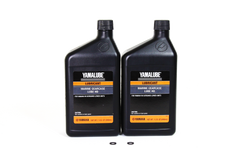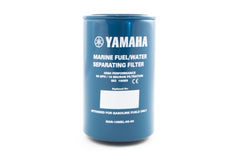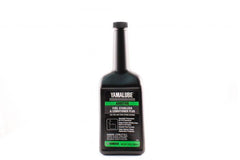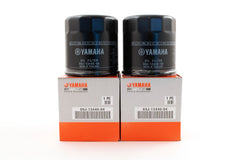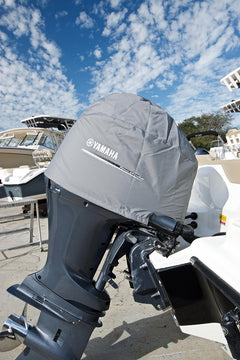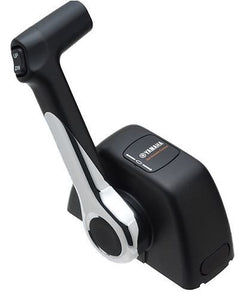Yamaha
Yamaha ACC-FSTAB-PL-32 - Yamalube Fuel Stabilizer and Conditioner Plus - 32 oz. Bottle
$12.18 USD$12.75 USDUnit price /UnavailableYamaha
Yamaha ACC-RNGFR-PL-12 - Yamalube Outboard Ring Free Plus Fuel Additive - 12 oz
$24.14 USD$25.40 USDUnit price /UnavailableYamaha
Yamaha ACC-STORE-RI-TE - Yamalube Stor-Rite Engine Fogging Oil - 12 oz.
$9.85 USD$9.99 USDUnit price /Unavailable-
 Shop Now
Shop NowYamaha Spring Essentials
Yamaha
Yamaha ACC-STORR-IT-32 - Yamalube EFI Engine Storage Fogging Oil - 32 OZ.
$10.24 USD$10.80 USDUnit price /UnavailableYamaha
Yamaha ACC-FSTAB-PL-12 - Yamalube Fuel Stabilizer and Conditioner Plus - 12 oz. Bottle
$6.05 USD$6.35 USDUnit price /UnavailableYamaha
Yamaha ACC-RNGFR-PL-32 - Yamalube Outboard Ring Free Plus Fuel Additive - 32 oz
$76.97 USD$81.35 USDUnit price /UnavailableYamaha
Yamaha ACC-FSTAB-PL-32 - Fuel Stabilizer and Conditioner Plus - 32 oz. Bottles - Case of 6
$73.08 USDUnit price /UnavailableYamaha
Yamaha ACC-FSTAB-PL-32 - Yamalube Fuel Stabilizer and Conditioner Plus - 32 oz. Bottle - 2-Pack
$24.36 USDUnit price /UnavailableYamaha
Yamaha ACC-RNGFR-PL-12 - Yamalube Outboard Ring Free Plus Fuel Additive - 12 oz - 2-Pack
$48.28 USDUnit price /UnavailableYamaha
Yamaha ACC-RNGFR-PL-12 - Yamalube Outboard Ring Free Plus Fuel Additive - 12 oz - 4-Pack
$96.56 USDUnit price /UnavailableYamaha
Yamaha ACC-FSTAB-PL-12 - Fuel Stabilizer and Conditioner Plus - 12 oz. Bottle- 12-Pack
$72.60 USDUnit price /UnavailableYamaha
Yamaha ACC-STORE-RI-TE - Yamalube Stor-Rite Engine Fogging Oil - 12 oz. - 2-Pack
$19.70 USDUnit price /UnavailableYamaha
Yamaha ACC-RNGFR-PL-32 - Yamalube Outboard Ring Free Plus Fuel Additive - 32 oz. - 2-Pack
$153.94 USDUnit price /UnavailableYamaha
Yamaha ACC-FSTAB-PL-12 - Fuel Stabilizer and Conditioner Plus - 12 oz. Bottle - 4-Pack
$24.20 USD$24.80 USDUnit price /UnavailableYamaha
Yamaha ACC-RNGFR-PL-32 - Yamalube Outboard Ring Free Plus Fuel Additive - 32 oz - Case of 6
$461.82 USDUnit price /UnavailableYamaha
Yamaha ACC-RNGFR-PL-12 - Yamalube Outboard Ring Free Plus Fuel Additive - 12 oz - 12-Pack
$289.68 USDUnit price /UnavailableYamaha
Yamaha ACC-STORR-IT-32- Yamalube EFI Engine Storage Fogging Oil - 32 oz. - 2-Pack
$20.48 USDUnit price /UnavailableYamaha
Yamaha ACC-STORE-RI-TE - Stor-Rite Engine Fogging Oil 12oz - 12-Pack
$118.20 USDUnit price /UnavailableYamaha
Yamaha ACC-STORE-RI-TE - Yamalube Stor-Rite Engine Fogging Oil - 12 oz. - 4-Pack
$39.40 USDUnit price /Unavailable
Yamalube Fogging Oils & Fuel Additives
Keeping your outboard in peak condition starts with Yamaha fogging oils and fuel additives. These specially formulated products protect internal components, improve fuel efficiency, and extend engine life. Whether you need Yamaha fuel additive to keep your fuel system clean or Yamaha fogging oil to safeguard your engine during storage, Yamaha offers solutions specifically for marine applications.
Using Yamaha fogging oils and fuel additives prevents carbon buildup, corrosion, and ethanol-related issues that can impact performance. The right oil and additives ensure smooth operation, reducing wear and tear while maximizing horsepower.
For both routine use and seasonal storage, Yamaha’s high-quality lubricants and treatments provide the ultimate protection. Trust in OEM-approved formulas to enhance reliability and make sure your outboard is always ready for the water.
YamahaOnlineParts.com has a wide variety of officially approved Yamalube fuel additives and fogging oils that can help keep your Yamaha outboard engine operating at its best, even when it’s not in use. These fogging oils and fuel additives prevent moisture, rust, and corrosion from damaging your outboard motor’s components while it sits idle in storage for months at a time. During long-term storage, moisture can build up in the outboard gas tank, and that moisture can eventually produce the dreaded rust and corrosion every boat owner fears. But fear not, as outboard motor fogging oil will ensure your boat returns from its long-term storage rust-free. Buy our Yamaha outboard motor fuel additives and fogging oils individually or in a set of multiple bottles, so you get a discount when purchasing them in large quantities.
To help you service your Yamaha OEM parts and accessories with Yamalube products, we also offer these helpful resources:
- Yamaha outboard engine schematics
- Winterizing Yamaha Outboard Motors - Here's How
- Yamaha Ring Free Plus – Is It Essential?
- Guide to Yamaha Outboard Fuel Filters
Yamalube Fuel Additives and Fogging Oils FAQs
How do I fog my Yamaha outboard engine?
Before fogging your Yamaha outboard engine, you’ll need the following:
- Fogging oil
- Crescent wrench
- Replacement spark plugs
- Motor flusher
- Garden hose
- Water supply
Yamalube fogging oil is a wax-based oil that provides a layer of protection to the engine and keeps it from corroding. As you go through the process, you will soon comprehend why it is labeled fogging the engine as there will be enormous amounts of white smoke.
As you will not be submerged in liquid when completing this activity, it is necessary to use a motor flusher to cool the engine while you finish the fogging process. Refer to the instructions for "Flush Your Outboard with the Engine Running" for more information.
If necessary, take the air cleaner cover off the engine in order to access the carburetor or air intake of the cylinders. Increase the speed of the engine slightly more than idle, and with the motor running, direct the fogging oil into the carburetor or air intake of each cylinder.
Keep applying fogging oil to the carburetors or cylinder air intake of the engine in a continuous manner until it stops. Make certain to coat every cylinder or carburetor with fogging oil. Do not apply too much oil in one go, as this can cause the engine to stop running straight away, however, with continued spraying, the engine will eventually shut down. This is the desired result, and when the engine stops, it means that it is properly covered in fogging oil.
After that, take out the spark plugs with your crescent wrench and spray a fogging oil into every cylinder. Rotate the flywheel to rotate the cylinders and cover the entire wall. Alternatively, you can just start the engine for short time to spread the fogging oil to coat the cylinder walls and do that a couple of times for a reliable result. Put in the new spark plugs to be all set for the spring.
How do I stabilize the fuel system of my Yamaha outboard motor?
Before stabilizing the fuel system of your Yamaha outboard engine, you’ll need the following::
- Fuel stabilizer suitable for long-term storage
- Motor flusher
- Garden hose
- Water supply
It is quite common for us to run our vehicles on ethanol-enriched gasoline, but we suggest that you use a fuel stabilizer whenever it is employed. If you want to discover why, take a look at the Ethanol Gasoline In Outboard Engines article. Furthermore, it is essential that you utilize a fuel stabilizer such as Yamaha Fuel Stabilizer and Conditioner Plus in the event that your boat is not going to be used for more than two or three months.
If you are intending to store your engine for longer than two months, you should add the quantity of fuel stabilizer indicated on the product's package - for example, one ounce of Yamaha Fuel Stabilizer and Conditioner Plus for each gallon of gas. If, however, the engine will be stored for two months or shorter, Yamaha suggests adding one ounce of stabilizer per three gallons of gas.
Allow the motor to operate with the stabilized fuel for a span of 10-15 minutes to make sure it is evenly spread throughout the fuel system. If the boat is not in the water, adhere to the steps outlined above for flushing the motor while it is in operation.
Why is my Yamaha outboard fuel system important?
The fuel system is composed of a bunch of components, including the fuel pump, fuel filter, valves, hoses, diaphragm, and injectors. If you don't hear the system running, you should examine the continuity between the fuse holder, fuse, fuel pump relay, and wiring harness. If there is no continuity, replace the faulty part. On the other hand, if there is continuity, replace the electric fuel pump. If you do hear the system running, check each element of the fuel system separately.
Begin by examining the Yamaha fuel filters and investigate for any blockages, breaks, twists, or ruptures in the pipes. Substitute any components that are damaged. Subsequently, inspect the diaphragm for any fractures or other indications of harm. After that, evaluate the vapor separator needle valve for curves or signs of deterioration. The following activity is to scrutinize the injectors for obstructions and opposition. Finally, look for faulty connections.
At the end, make sure to observe if there is any H2O present in the fuel. Ethanol-based gasoline is capable of attracting water, which lessens the combustibility of the fuel. This is especially likely to happen if you don't use any fuel enhancers or stabilizers. Water in the fuel may also cause the fuel pump to malfunction. In the event that you discover water in the fuel, it is suggested to check if the pump is functioning correctly.
To carry out a fuel pump test on a Yamaha outboard engine, first disconnect the spark plug wire boot from the spark plug and then unscrew the spark plug with a plug socket and wrench. Place the compression gauge into the spark plug socket. In the case of electric motors, you will require someone to turn the engine over while you adjust the throttle to the full open position. For manual starters, you can open the throttle with one hand and pull the start rope with the other.
Why is a proper Yamaha outboard season breakout important?
At the commencement of the boating season, it is advised that individuals take the necessary steps to properly prepare their Yamaha outboard for the season. At the launch ramp, one can easily distinguish between those who have gone through the right preparations and those who have not. To avoid being the one to disappoint the family and friends who are eagerly awaiting a boat ride, it is important to carry out a few basic maintenance tasks on the Yamaha motor before taking the boat out. This will spare you any discomfort and reduce the amount of time wasted.
How do I perform a Yamaha outboard season breakout?
- It is debatable whether you should fill your fuel tank before storing it. But, no matter what approach you take, it is crucial to use a quality fuel treatment when the season begins. Therefore, YamahaOnlineParts.com advises adding Yamaha Ring Free to your fuel tank and topping off the gas. Furthermore, when using ethanol fuel, it is important to also use Yamaha Fuel Stabilizer and Conditioner.
- Examine the joints of the fuel system for any seepage, and the fuel pipes for any signs of softness or fragility. Substitute them if necessary.
- Inspect the grounding wires attached to the motor-supporting bracket for any signs of damage or rust. If needed, clean them.
- Ensure that the batteries are powered up, and reconnect the cables if they were detached before putting them away. It is ideal to give it a trickle charge when keeping the battery in storage, and Yamaha Battery Terminal Cleaner and Protector is a great product to use to clear away any corrosive deposits on the battery posts, which will help to boost the power and prolong its life.
- Examine your propeller and take it off. Apply Yamaha Marine Grease and verify that the seal of the lower unit has not been damaged.
- Check thoroughly for any leaks coming from the lower part of the engine. Yamaha Gear Lube Kits provide the necessary materials for optimal maintenance of the lower unit.
- Rotate the steering wheel, making sure that it is able to move freely throughout its full range.
- Apply lubricant to the tips of the mechanical wires where they attach to the control and to the motor.
- Look for any fluid leaks coming from the hydraulic system, take a close look at the hoses located near the engine and cylinders. Top off the marine hydraulic steering fluid if necessary.
- Make sure that there are no leaks in the power-assisted systems, inspect the hoses and make sure the reservoir is full.
- If your boat motor has a power trim and tilt mechanism, make sure it is working properly. Look for any liquid leakage around the piston seals and repair/substitute them if necessary.
- It is essential to go through a trial run of the engine before taking the boat out on the water. This will clear away any fogging or storage oils that have been added to the motor. It will also give you the opportunity to assess all of the gauges, navigation, and electronic systems, look for any leaks, and ensure that the engine is working correctly before your initial voyage. The professionals at YamahaOnlineParts.com recommend using engine flushing earmuffs for the lower unit when running the engine without water.


